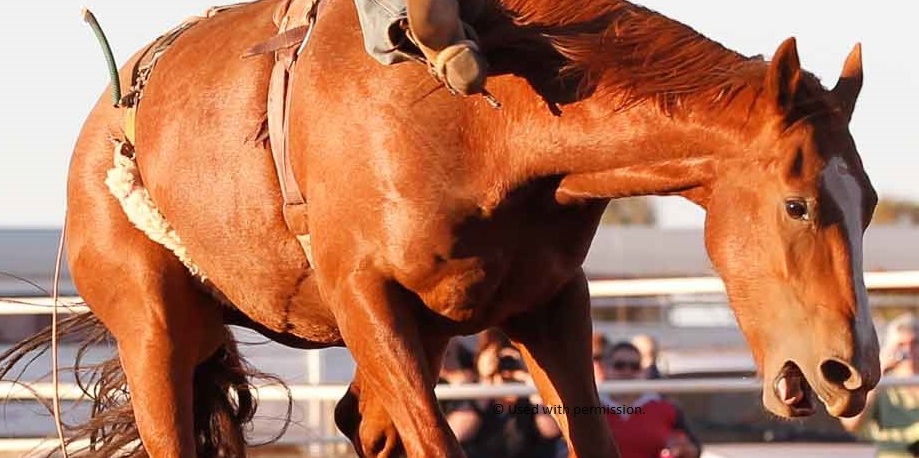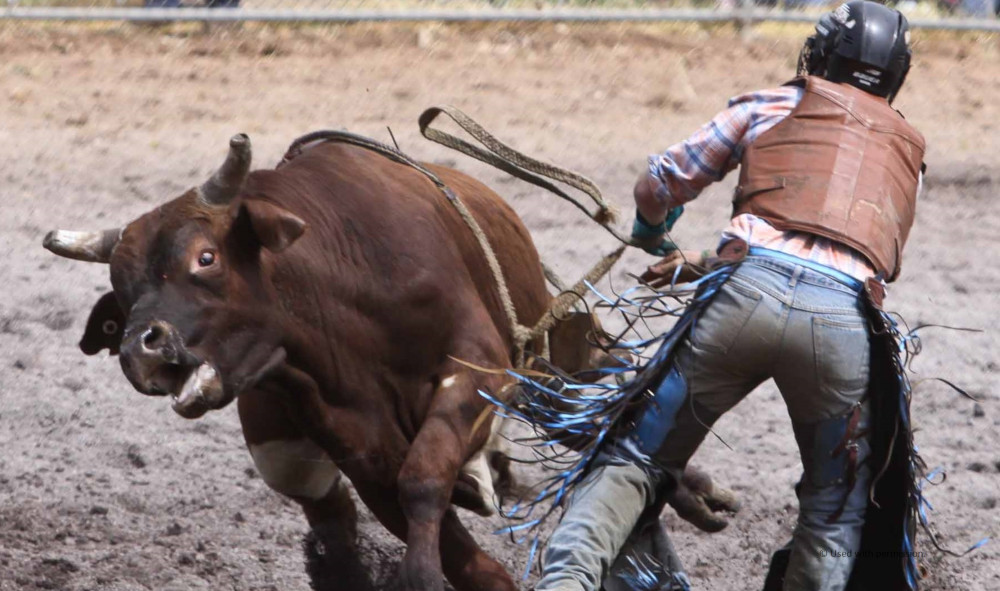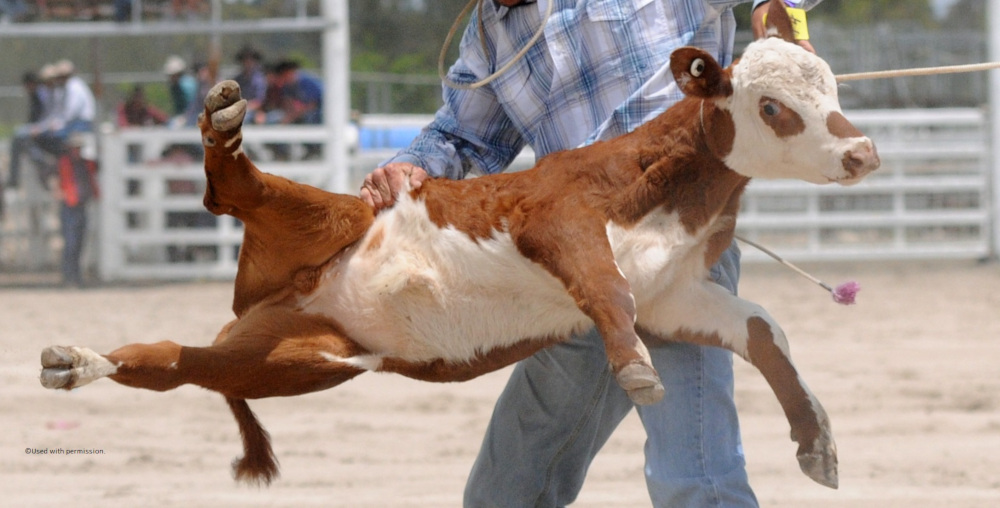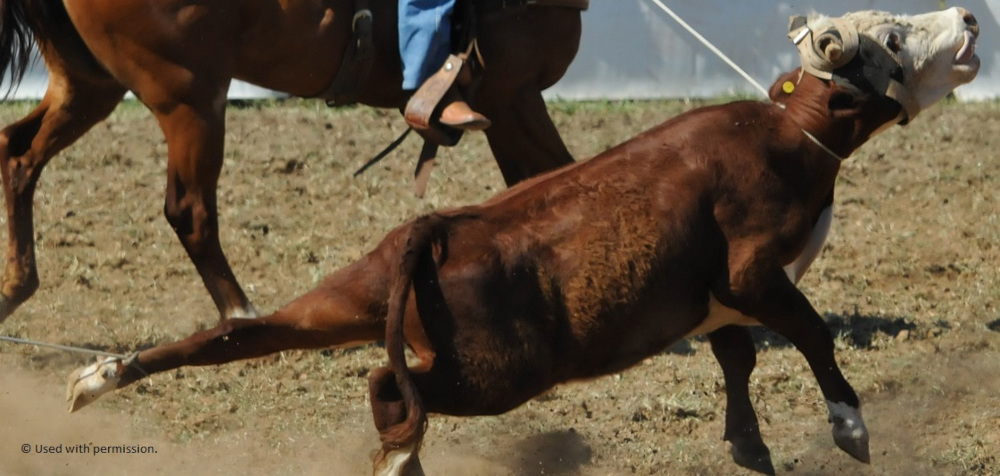A rodeo is a form of entertainment or sport where horses and cattle are used to demonstrate what the organisers say are riding and handling skills. Events include bronco riding, bull riding, calf roping, team roping and steer wrestling. The RSPCA is opposed to rodeos and rodeo schools because of the potential for significant injury, suffering or distress to the animals involved. Based on observed behaviour, there is very little evidence that the animals ‘enjoy’ the rodeo experience. Rodeos are held in all states and territories in Australia except for the Australian Capital Territory where they are prohibited.
Bronco and bull riding
Rodeo horses and bulls buck repeatedly as an instinctive reaction to being kicked with metal spurs and to the tightened flank strap around their sensitive underbelly. Horses and cattle are prey animals and their reaction to being ridden in this way is the same as their reaction to being attacked by a predator, a situation where they experience increased fear, stress and panic. It is not uncommon to see horses and bulls hurl themselves at solid objects to rid themselves of the rider. Only when the rider has been thrown or dismounts and the flank straps loosened do they quieten down. Also, some ridden animals are so distressed that they then charge the rider on the ground, further demonstrating this very strong fear response. A study of bull behaviour at rodeos determined that nearly one third of animals assessed showed signs of distress leading up to the start of bull riding events and that those who did not react may have either become habituated to the aversive situation or have given up thereby being forced to endure the negative experience [1].
A relatively new form of rodeo being promoted in Australia is professional bull riding where bulls are ridden while subjected to loud noises and pyrotechnics amid clapping and cheering. In December 2017, a bull suffered a broken leg and had to be euthanased during one of these events in Adelaide. Forcing animals to endure this suffering for sport and entertainment is unnecessary and inhumane.
Another event which is very concerning involves competitors as young as eight years of age riding steers with other similar events involving children up to 14 years. As with other rodeo events, the young steers are subjected to harassment to encourage bucking, which causes fear and stress. Promoting children’s events like this conveys a message that it is acceptable to frighten animals for sport and entertainment, when it is not.


Calf roping
Although all rodeo events pose significant animal welfare risks, calf roping (also known as rope-and-tie) raises serious concerns, as it subjects young vulnerable animals to unnecessary harm and distress. Calf roping involves releasing the animal ahead of the competitor/roper who is on horseback. The rider will chase and lasso the calf by throwing a rope over the neck. The rider then dismounts and runs to the animal, relying on his horse to keep the calf from running by maintaining tension on the rope, which often causes choking. After catching the animal, the rider forces the calf to the ground to then tie three of the calf’s legs with rope. Injury risks include damage to the calf’s neck (soft tissue, windpipe and spine), bruising, broken ribs and choking. A Queensland study has shown that rodeo calves experience stress [2]. Two studies by the University of Sydney reveal that calves being used for roping were frightened, stressed and anxious [3,4].


Calf roping is effectively banned in two states, Victoria and South Australia, through a mandated minimum body weight of 200 kg for cattle used in rodeos. In other states, calves as light as 100 kg can be used for roping and there are no laws prohibiting the use of unweaned or recently weaned calves. A review by Deakin University found inconsistencies in regulation of calf roping between Australian jurisdictions [5]. The authors concluded that calf roping causes unnecessary harm which raises concerns regarding the adequacy of legal protection for calves in jurisdictions where calf roping is permitted.
Steer wrestling and team roping
Steers between 180kg and 300kg are used for both wrestling and team roping events. Steer wrestling involves a competitor on horseback chasing the steer released from the chute, to then jump off the horse to grab the steer by the horns and twist the neck 180° to force the steer to the ground. In addition to the fear of being chased and handled in such a rough manner, during this event some steers have had their horns damaged with deaths occurring due to their neck being broken. Other injury risks in steer wrestling include damage to the animal’s windpipe and muscle and tissue bruising. With team roping, two riders chase the steer who has been released from the chute with one rider roping both of the steer’s hind legs and the other roping the steer around the head, neck or horns to force the steer to stop. The steer in many cases is fully stretched out by the ropes holding their hind legs and head and will be forced to the ground as they are unable to use their hind legs to stand. Due to the chasing and roping, many steers appear to be confused and distressed; in addition, the animal has no control over their situation which can cause fear, stress and anxiety.


A review by the New Zealand National Animal Welfare Advisory Committee concluded that all rodeo events posed serious or moderate concerns except for barrel racing which was considered to be of minor concern [6]. The committee considered steer wrestling and calf rope-and-tie events to raise serious concerns as they regularly cause negative impacts, and potentially quite substantial impacts [6]. The Australian Veterinary Association does not support steer wrestling or calf rope-and-tie events and is concerned about the animal welfare impacts associated with the use of flank straps and spurs [7].
Rodeos don’t reflect farm practices
Rodeo events do not reflect best practice cattle handling or horsemanship. Calves are not roped, bulls are not ridden and steers are not wrestled as normal husbandry. Animals are not or should not be handled as demonstrated by rodeo events on any farm or station as part of normal husbandry practices. In fact, the agricultural industry strongly promotes low stress stock handling to avoid animals being stressed or injured.
Community concerns
In 2015, an independent survey commissioned by the RSPCA showed 52% of respondents in Australian urban and rural areas were concerned or very concerned about the welfare of animals in rodeos. In 2018, this increased by 11% to 63%. Polling conducted in 2022 found another increase by 4% showing 67% of the public concerned or very concerned about the welfare of animals in rodeos. This indicates that the vast majority of Australians are concerned about the welfare of animals in rodeos, with the trend increasing.
Rodeos are promoted as family fun entertainment but rather than teaching children empathy, compassion and respect for animals, it condones animals being chased, choked, thrown and kicked with children being encouraged to participate.
There is also an increasing number of travel agents and tourism companies who have animal welfare policies which include boycotting promoting specific animal-based attractions. The Association for British Travel Agents Guidelines also list rodeos as an unacceptable practice involving animals in cultural events and activities.
The RSPCA is opposed to rodeo and rodeo schools. However, where rodeos are permitted, the RSPCA advocates the adoption of compulsory and enforced animal welfare standards through a registration and licensing system which includes management, handling, housing and transport of rodeo animals. Attendance by a suitably qualified veterinarian should also be mandatory at all rodeo events to ensure prompt and appropriate veterinary care is provided to animals as required.
What you can do
All rodeo events will cause stress, fear and pain as well as injure animals for the sake of sport and entertainment. Subjecting cattle and horses to these experiences is not justified. You can help stop rodeos by raising awareness of the risks to animals inherent in rodeos, especially if a rodeo is held in your local community. You can also meet with your local member of Parliament and write to the Minister responsible for animal welfare in your state/territory to urge rodeos to cease.
Relevant podcast
https://open.spotify.com/episode/5tkF75s2bMSJc3VxA2zCHn?si=6Q7rihmBRkqW5vjK8pNAnA
References
[1] Goldhawk C, Bond G, Grandin T, Pajor E (2016) Behaviour of bucking bulls prior to rodeo performances and relation to rodeo and human activities. Applied Animal Behaviour Science 181:63–69.
[2] Sinclair M, Keeley T, Lefebvre A, and Phillips C (2016) Behavioural and physiological responses of calves to marshalling and roping in a simulated rodeo event. Animals 6(30).
[3] Rizzuto S, Evans D, Wilson B, McGreevy P (2020) Exploring the use of a Qualitative Behavioural Assessment approach to assess emotional state of calves in rodeos. Animals 10(1) 113 doi.org/10.3390/ani10010113.
[4] Dixon S, Evans D, Vindevoghel T, Ward MP, Quain A (2023) Behaviours expressed by rodeo calves during different phases of roping. Animals 13(343) https://doi.org/10.3390/ani13030343.
[5] Stonebridge M, Evans D, Kotzmann J (2022) Sentience matters: Analysing the regulation of calf-roping in Australian rodeos. Animals 12, 1071
[6] New Zealand National Animal Welfare Advisory Committee (2018) Rodeo events – How do they impact the sentient animal? Assessing the animal welfare impacts that rodeo events may have, through a five domains of animal welfare approach.
[7] Australian Veterinary Association (2023) Welfare of animals used in rodeos. Rodeos (ava.com.au)

